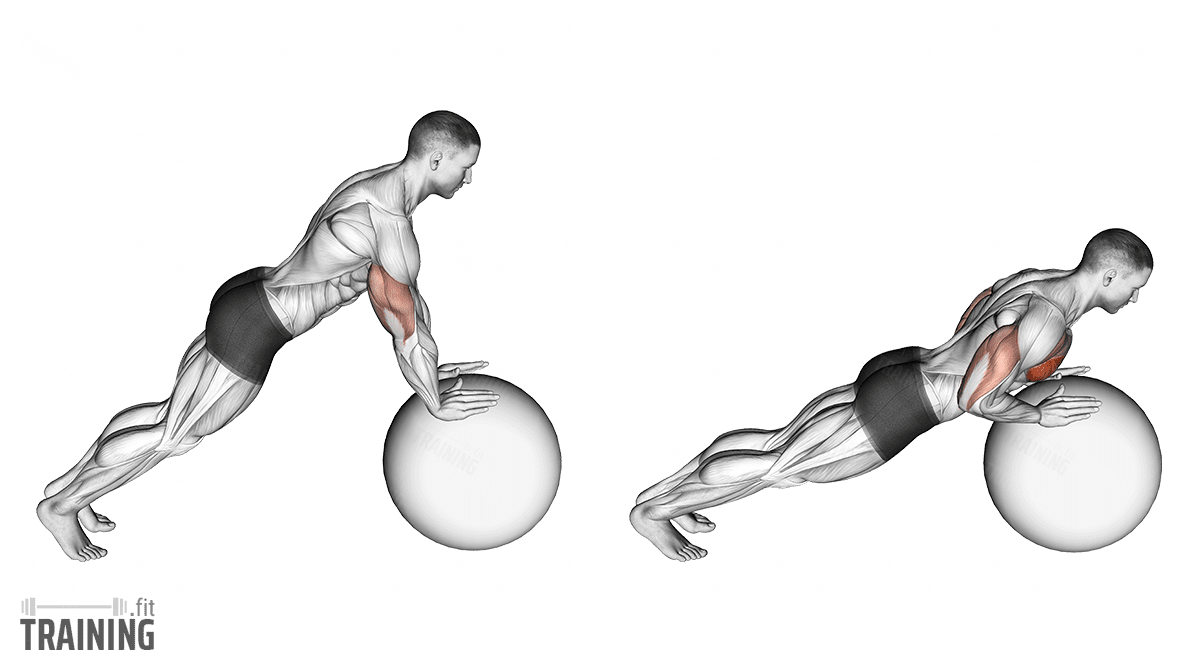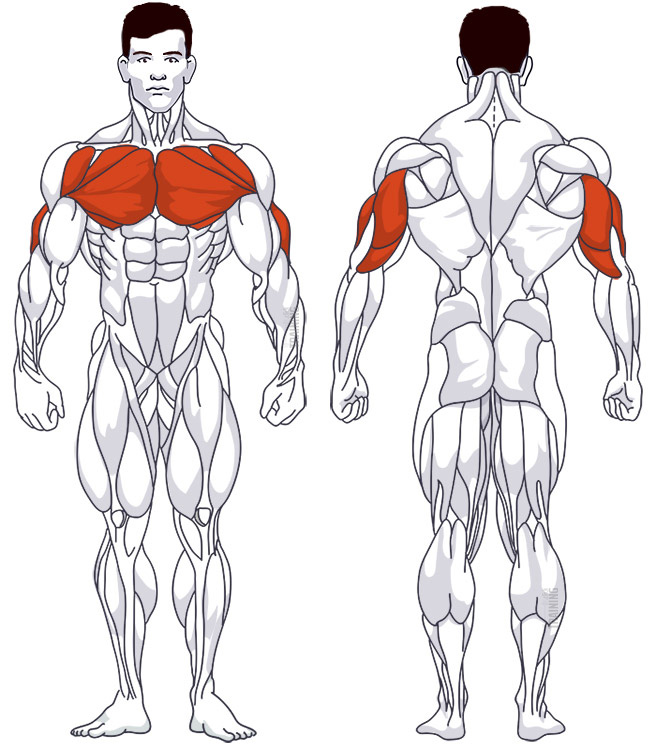Push-Ups with Exercise Ball
Isolation exercise, Body weightThis article is verified by 2 studies/publications.
Overview

Main muscles
- Chest: Large pectoral muscle
(Musculus pectoralis major) - Chest: Small pectoral muscle
(Musculus pectoralis minor) - Shoulder: Anterior deltoid muscle
(Musculus deltoideus, Pars clavicularis) - Triceps: Three-headed arm muscle
(Musculus triceps brachii)
Training plans
Push-Ups with Exercise Ball is a suitable substitute for similar exercises in Chest training or as a supplement to various training plans.
Push-Ups with Exercise Ball: Basics and alternatives

Involved main muscle groups:
Push-Ups with Exercise Ball
Push-ups with a gymnastics ball are a unique variation of classic push-ups. In this exercise, instead of placing your hands on the floor or a flat surface, you place them on a ball. This increases instability and engages the triceps more [1], putting greater emphasis on the arms.
The basic movement stays the same: with outstretched arms and an extended body, you support yourself on the ball with your arms and on the ground with your toes. By bending and straightening your arms, you primarily move your upper body.
Although this exercise focuses more on tricep training, the chest is still involved, making push-ups with a gymnastics ball a compound exercise.
Other push-up variations include negative push-ups and classic push-ups.
Correct execution
Push-ups with a gymnastics ball demand a high level of body tension. To prevent the ball from slipping, you need to tense your core and apply pressure to the ball through your chest muscles. This ensures your chest muscles are more engaged than in regular push-ups, regardless of the movement.
Alternatively, you can perform the exercise with a medicine ball, which is less mobile, requiring less stabilization from your chest muscles.
It’s important to remember that the higher arm support shifts the center of gravity towards your legs. This means you’re moving less weight [2], which may result in slightly less muscle activation compared to classic push-ups or negative push-ups, depending on your training status.
Video tutorial
Step-by-step instructions
Kneel on the floor, lean forward, and place your hands on the exercise ball, shoulder-width apart.
Lift your knees, move your legs back far enough so your body is stretched out, and stand on your toes. Keep supporting your arms on the ball, making sure it remains stable. Do this by placing your hands slightly to the side and pressing the ball towards the center from both sides.
Extend both arms.
Tighten your core so your head, upper body, and legs form an almost straight line. In this exercise, it’s okay to stick your butt out a little (but not too much) for better stability, unlike with normal push-ups.
Slowly and with control, lower your upper body by bending your arms. Stop the movement when your chest is just above the ball.
Hold the position for a brief moment and then extend your arms again (almost completely). Maintain tension in your body as previously described throughout the entire movement.
Common mistakes
The increased instability of gymnastics ball push-ups also carries a higher risk of injury. If the ball slips due to carelessness, you could land on your hands or face with force. Therefore, only perform this exercise if you have enough strength to ensure the necessary stability. Beginners should stick to classic push-ups first.
Other possible errors in this exercise are similar to those in regular push-ups. Incorrect body posture can cause the exercise to be less effective. Pay attention to maintaining as straight a line as possible between your head, hips, and legs. However, unlike classic push-ups, it’s okay to raise your butt slightly for better body stability.
Ensure you use the full range of motion and completely bend and extend your arms. With the higher hand placement, the weight is already lighter, so if the execution is poor, the training stimulus will be much lower.
Sources
- Shoulder muscle EMG activity during push up variations on and off a Swiss ball. Lehman, G. J., MacMillan, B., MacIntyre, I., Chivers, M., & Fluter, M. (2006). Dynamic Medicine, 5(1), 7. doi:10.1186/1476-5918-5-7. URL: https://www.ncbi.nlm.nih.gov/pmc/articles/PMC1508143/, accessed on 11/19/2020
- Kinetic Analysis of Several Variations of Push-Ups. Ebben, W. P., Wurm, B., VanderZanden, T. L., Spadavecchia, M. L., Durocher, J. J., Bickham, C. T., & Petushek, E. J. (2011). Journal of Strength and Conditioning Research, 25(10), 2891–2894. doi:10.1519/jsc.0b013e31820c8587. URL: https://pubmed.ncbi.nlm.nih.gov/21873902/, accessed on 11/18/2020